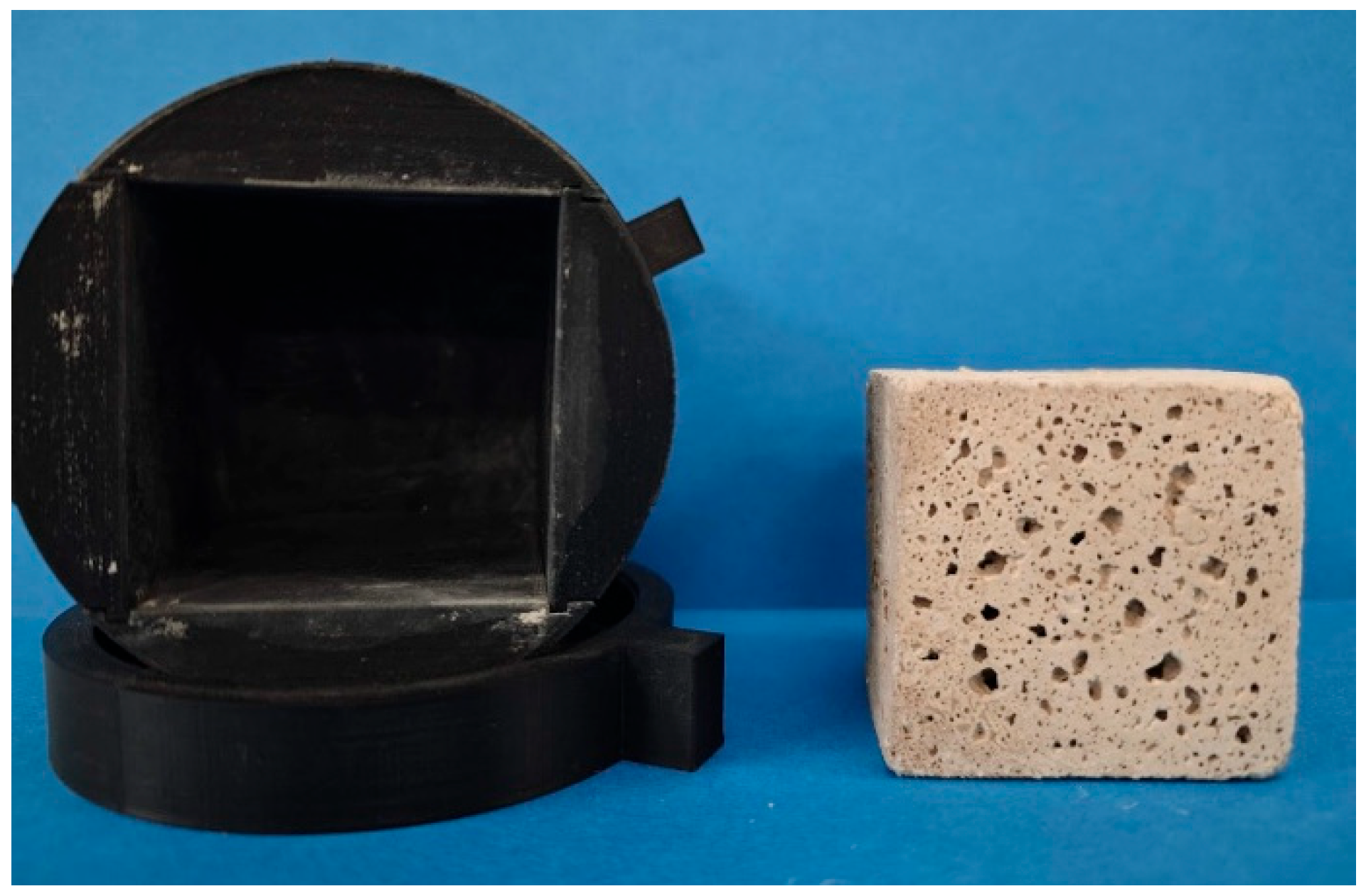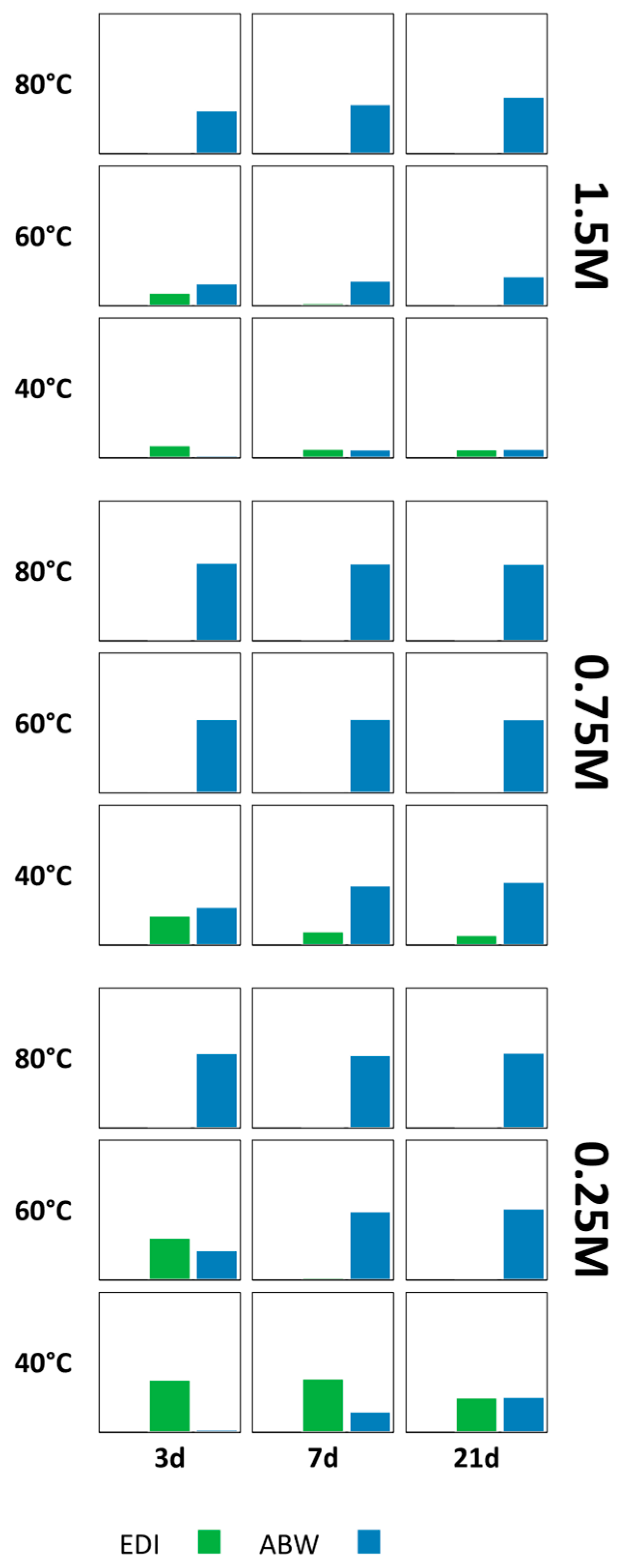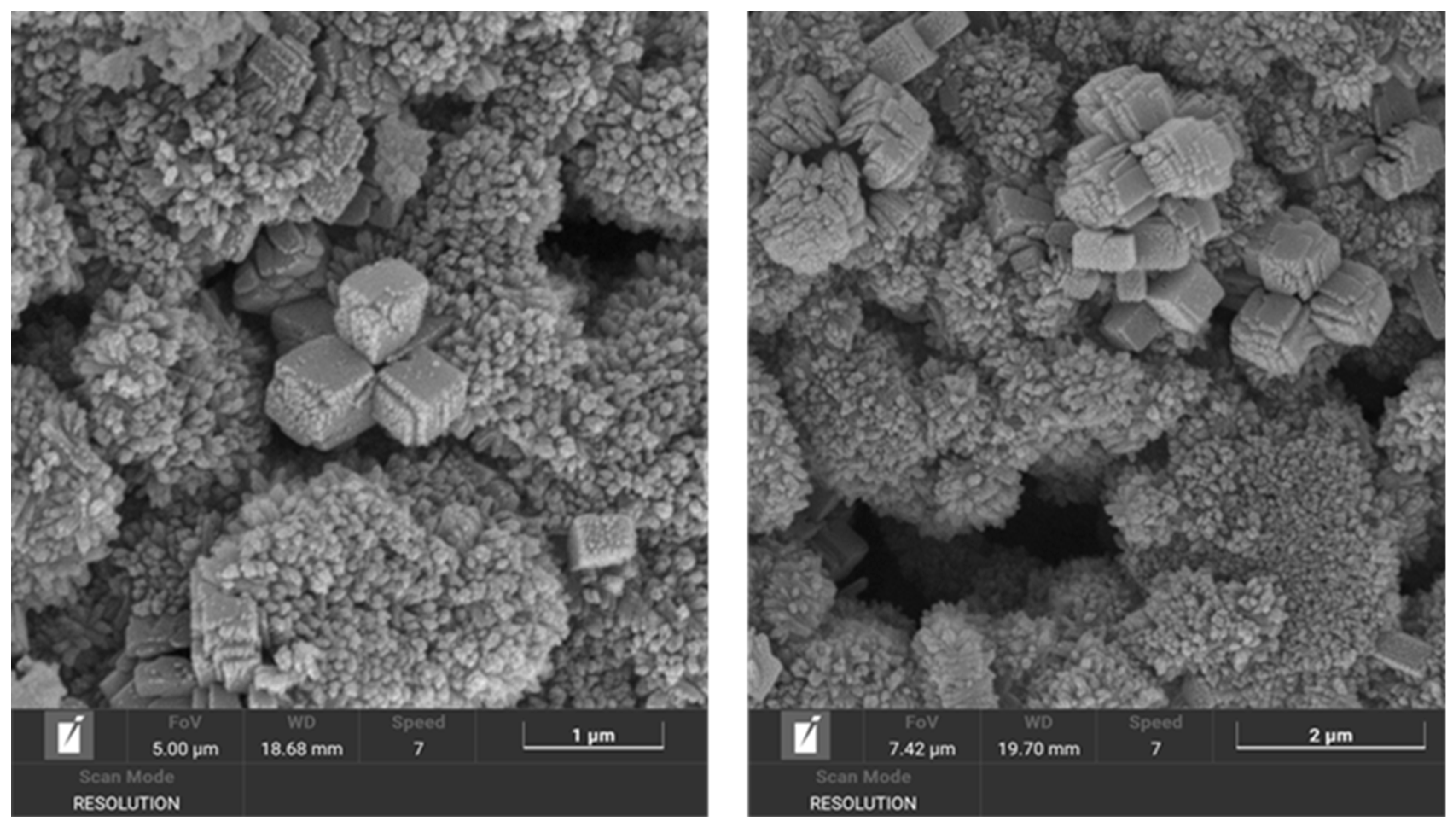Crystallization of Lithium Zeolites onto Foamed Geopolymers
Abstract
1. Introduction
2. Experimental Section
2.1. Synthesis of the Foamed Zeolite-Rich Geopolymer
2.2. Sample Characterization
2.3. Response Analysis and Model Fitting
3. Results and Discussion
3.1. Na/Li-Route
3.1.1. Occurrence of ABW
3.1.2. Occurrence of Edingtonite
3.2. Li-Route
3.2.1. Occurrence of ABW
3.2.2. Occurrence of Edingtonite
4. Final Discussion and Conclusions
Supplementary Materials
Author Contributions
Funding
Data Availability Statement
Conflicts of Interest
References
- Provis, J.L.; Lukey, G.C.; Van Deventer, J.S.J. Do Geopolymers Actually Contain Nanocrystalline Zeolites? A Reexamination of Existing Results. Chem. Mater. 2005, 17, 3075–3085. [Google Scholar] [CrossRef]
- Papa, E.; Medri, V.; Amari, S.; Manaud, J.; Benito, P.; Vaccari, A.; Landi, E. Zeolite-geopolymer composite materials: Production and characterization. J. Clean. Prod. 2018, 171, 76–84. [Google Scholar] [CrossRef]
- Liguori, B.; Aprea, P.; Roviello, G.; Ferone, C. Self-supporting zeolites by Geopolymer Gel Conversion (GGC). Microporous Mesoporous Mater. 2019, 286, 125–132. [Google Scholar] [CrossRef]
- Chen, S.; Zhang, W.; Sorge, L.P.; Seo, D.-K. Exploratory Synthesis of Low-Silica Nanozeolites through Geopolymer Chemistry. Cryst. Growth Des. 2019, 19, 1167–1171. [Google Scholar] [CrossRef]
- Didi, Y.; Said, B.; Cacciaguerra, T.; Nguyen, K.L.; Wernert, V.; Denoyel, R.; Cot, D.; Sebai, W.; Belleville, M.-P.; Sanchez-Marcano, J.; et al. Galarneau, Synthesis of binderless FAU-X (13X) monoliths with hierarchical porosity. Microporous Mesoporous Mater. 2019, 281, 57–65. [Google Scholar] [CrossRef]
- Khalid, H.R.; Lee, N.K.; Park, S.M.; Abbas, N.; Lee, H.K. Synthesis of geopolymer-supported zeolites via robust one-step method and their adsorption potential. J. Hazard. Mater. 2018, 353, 522–533. [Google Scholar] [CrossRef]
- Candamano, S.; Policicchio, A.; Conte, G.; Abarca, R.; Algieri, C.; Chakraborty, S.; Curcio, S.; Calabrò, V.; Crea, F.; Agostino, R.G. Preparation of foamed and unfoamed geopolymer/NaX zeolite/activated carbon composites for CO2 adsorption. J. Clean. Prod. 2022, 330, 16. [Google Scholar] [CrossRef]
- Campanile, A.; Liguori, B.; Ferone, C.; Caputo, D.; Gigli, L.; Aprea, P. From geopolymers to zeolites: Synthesis and characterization of foamed FAU-X monoliths. Microporous Mesoporous Mater. 2023, 349, 112426. [Google Scholar] [CrossRef]
- Jin, Y.; Li, L.; Liu, Z.; Zhu, S.; Wang, D. Synthesis and characterization of low-cost zeolite NaA from coal gangue by hydrothermal method. Adv. Powder Technol. 2021, 32, 791–801. [Google Scholar] [CrossRef]
- Wang, H.; Yan, C.; Li, D.; Zhou, F.; Liu, Y.; Zhou, C.; Komarneni, S. In situ transformation of geopolymer gels to self-supporting NaX zeolite monoliths with excellent compressive strength. Microporous Mesoporous Mater. 2018, 261, 164–169. [Google Scholar] [CrossRef]
- Mastropietro, T.F.; Drioli, E.; Candamano, S.; Poerio, T. Crystallization and assembling of FAU nanozeolites on porous ceramic supports for zeolite membrane synthesis. Microporous Mesoporous Mater. 2016, 228, 141–146. [Google Scholar] [CrossRef]
- O’Connor, S.J.; MacKenzie, K.J.D. Synthesis, characterisation and thermal behaviour of lithium aluminosilicate inorganic polymers. J. Mater. Sci. 2010, 45, 3707–3713. [Google Scholar] [CrossRef]
- Zhou, L.; Wang, A.; Li, H.; Zhou, W.; Wang, J.; Luo, Y.; Qian, B.; Liang, R.; Gao, H.; Li, Y.; et al. Effects of Curing Temperature and Water Glass Modulus on the Preparation of Hierarchical Zeolite Precursors. Silicon 2023, 15, 4585–4601. [Google Scholar] [CrossRef]
- Onutai, S.; Sato, J.; Osugi, T. Possible pathway of zeolite formation through alkali activation chemistry of metakaolin for geopolymer–zeolite composite materials: ATR-FTIR study. J. Solid State Chem. 2023, 319, 123808. [Google Scholar] [CrossRef]
- Zhang, X.; Bai, C.; Qiao, Y.; Wang, X.; Jia, D.; Li, H.; Colombo, P. Porous geopolymer composites: A review. Compos. Part. A Appl. Sci. Manuf. 2021, 150, 106629. [Google Scholar] [CrossRef]
- Campanile, A.; Liguori, B.; Ferone, C.; Colella, A.; Caputo, D.; Aprea, P. Design of physical and functional properties of zeolitic porous monoliths by combining different foaming additives. Ceram. Int. 2024, 50, 53373–53381. [Google Scholar] [CrossRef]
- Campanile, A.; Liguori, B.; Ferone, C.; Caputo, D.; Aprea, P. Zeolite-based monoliths for water softening by ion exchange/precipitation process. Sci. Rep. 2022, 12, 3686. [Google Scholar] [CrossRef]
- Li, C.J.; Zhang, Y.J.; Chen, H.; He, P.Y.; Zhang, Y.; Meng, Q. Synthesis of fly ash cenospheres-based hollow ABW zeolite for dye removal via the coupling of adsorption and photocatalysis. Adv. Powder Technol. 2021, 32, 3436–3446. [Google Scholar] [CrossRef]
- He, P.Y.; Zhang, Y.J.; Chen, H.; Han, Z.C.; Liu, L.C. Low-cost and facile synthesis of geopolymer-zeolite composite membrane for chromium(VI) separation from aqueous solution. J. Hazard. Mater. 2020, 392, 122359. [Google Scholar] [CrossRef]
- He, P.; Zhang, Y.; Zhang, X.; Chen, H. Diverse zeolites derived from a circulating fluidized bed fly ash based geopolymer for the adsorption of lead ions from wastewater. J. Clean. Prod. 2021, 312, 127769. [Google Scholar] [CrossRef]
- Fujiki, J.; Yogo, K. Effect of Counter Cations on the Hydrothermal Conversion of FAU-Type Zeolites into ABW or ANA and Their Potential Applicability for CO2 /N2 Separation. J. Chem. Eng. Jpn. 2020, 53, 17–23. [Google Scholar] [CrossRef]
- Boer, D.G.; Langerak, J.; Pescarmona, P.P. Zeolites as Selective Adsorbents for CO2 Separation. ACS Appl. Energy Mater. 2023, 6, 2634–2656. [Google Scholar] [CrossRef]
- Hasan, M.M.F.; First, E.L.; Floudas, C.A. Cost-effective CO2 capture based on in silico screening of zeolites and process optimization. Phys. Chem. Chem. Phys. 2013, 15, 17601. [Google Scholar] [CrossRef]
- Boer, D.G.; Langerak, J.; Bakker, B.; Pescarmona, P.P. Binderless zeolite LTA beads with hierarchical porosity for selective CO2 adsorption in biogas upgrading. Microporous Mesoporous Mater. 2022, 344, 112208. [Google Scholar] [CrossRef]
- Yao, Z.; Ye, Y.; Xia, M. Synthesis and characterization of lithium zeolites with ABW type from coal fly ash. Env. Prog. Sustain. Energy 2013, 32, 790–796. [Google Scholar] [CrossRef]
- Yao, Z.T.; Xia, M.S.; Ye, Y.; Zhang, L. Synthesis of zeolite Li-ABW from fly ash by fusion method. J. Hazard. Mater. 2009, 170, 639–644. [Google Scholar] [CrossRef]
- Dou, H.; Ye, Q.; He, Y.; Cui, X. In-Situ Transformation of Li-ABW Zeolites Based on Li-Geopolymer. Gels 2023, 9, 392. [Google Scholar] [CrossRef] [PubMed]
- UNI 11060:2003; Cultural Heritage—Natural and Artificial Stones—Determination of Density and Voids. UNI-Ente Italiano di Normazione: Milan, Italy, 2003.
- Sathupunya, M.; Gulari, E.; Wongkasemjit, S. Microwave preparation of Li-zeolite directly from alumatrane and silatrane. Mater. Chem. Phys. 2004, 83, 89–95. [Google Scholar] [CrossRef]
- Gevaudan, J.P.; Campbell, K.M.; Kane, T.J.; Shoemaker, R.K.; Srubar, W.V. Mineralization dynamics of metakaolin-based alkali-activated cements. Cem. Concr. Res. 2017, 94, 1–12. [Google Scholar] [CrossRef]







Disclaimer/Publisher’s Note: The statements, opinions and data contained in all publications are solely those of the individual author(s) and contributor(s) and not of MDPI and/or the editor(s). MDPI and/or the editor(s) disclaim responsibility for any injury to people or property resulting from any ideas, methods, instructions or products referred to in the content. |
© 2025 by the authors. Licensee MDPI, Basel, Switzerland. This article is an open access article distributed under the terms and conditions of the Creative Commons Attribution (CC BY) license (https://creativecommons.org/licenses/by/4.0/).
Share and Cite
Gravino, C.; Campanile, A.; Ferone, C.; Caputo, D.; Gargiulo, N.; Liguori, B.; Aprea, P. Crystallization of Lithium Zeolites onto Foamed Geopolymers. Materials 2025, 18, 5310. https://doi.org/10.3390/ma18235310
Gravino C, Campanile A, Ferone C, Caputo D, Gargiulo N, Liguori B, Aprea P. Crystallization of Lithium Zeolites onto Foamed Geopolymers. Materials. 2025; 18(23):5310. https://doi.org/10.3390/ma18235310
Chicago/Turabian StyleGravino, Carlo, Assunta Campanile, Claudio Ferone, Domenico Caputo, Nicola Gargiulo, Barbara Liguori, and Paolo Aprea. 2025. "Crystallization of Lithium Zeolites onto Foamed Geopolymers" Materials 18, no. 23: 5310. https://doi.org/10.3390/ma18235310
APA StyleGravino, C., Campanile, A., Ferone, C., Caputo, D., Gargiulo, N., Liguori, B., & Aprea, P. (2025). Crystallization of Lithium Zeolites onto Foamed Geopolymers. Materials, 18(23), 5310. https://doi.org/10.3390/ma18235310












